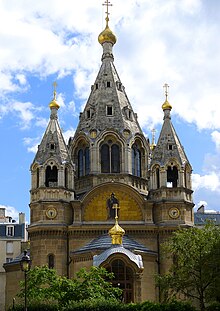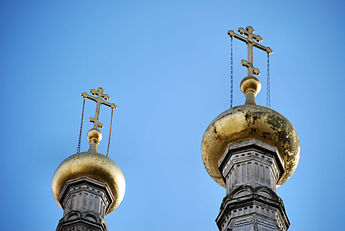|
Alexander Nevsky Cathedral, Paris
The Alexander Nevsky Cathedral (French: Cathédrale Saint-Alexandre-Nevsky, Russian: Собор Святого Александра Невского, romanized: Sobor Svyatogo Aleksandra Nyevskogo) is a Russian Orthodox cathedral church located at 12 Rue Daru in the 8th arrondissement of Paris. The closest métro station is Courcelles The Cathedral is the under the jurisdiction of the Archdiocese of Orthodox Churches of Russian Tradition in Western Europe, based in Istanbul. It should not be confused with the Holy Trinity Cathedral and the Russian Orthodox Spiritual and Cultural Center, which opened in Paris in 2016, under the authority of the Moscow patriarch and Russian government. Services in the main cathedral are conducted in Church Slavonic. Some services the Crypt are conducted in French. History The first Russian Orthodox church in Paris was a small oratory constructed on Rue de Berri in 1816. As the population of Russian immigrants in Paris grew during the 19th century, a larger church was needed. In 1847, the chaplain of the Russian Embassy in Paris, Father Joseph Vassiliev, received permission from Emperor Napoleon III to construct a larger church. The program was moved forward by a grant of 200,000 French francs from Czar Alexander II, whose patron saint was Alexander Nevsky (1219-1263) Nevsky had contributed to the unification of Russia as well the establishment of the Russian Orthodox church throughout the Russian empire.[2]  Work on the church began in 1859 under Roman Kouzmine, chief architect of the Russian imperial Court, and the chef engineer Strohm. The cathedral was established and consecrated in 1861, making it the first Russian Orthodox place of worship in France.[3] The church was formally given cathedral status in 1951. During the Soviet period, it was the headquarters of an archbishop who supervised the other Russian Orthodox churches in Western Europe, independent of Moscow. Following the downfall of the Soviet Union, the church came under the jurisdiction of the Ecumenical Patriarchate of Constantinople, established in 1931, located in Istanbul, independent of Moscow. The cathedral became the see of the Archdiocese of Russian Orthodox Churches in Western Europe.[4] In 2016, the Russian Orthodox church opened a new cathedral in Paris, Holy Trinity Orthodox Cathedral, which is under the authority of the Patriarchal Exarchate in Western Europe (Moscow Patriarchate) in Moscow. The cathedral of Alexander Nevsky is independent of Moscow and the Saint Trinity cathedral. Exterior The exterior of the church is a good example, of what its builder, the Russian diplomat to France Joseph Valliliev, called "Byzantine Muscovite". It used the Byzantine form of Greek cross and a semi-circular fronton with a mosaic image of Christ giving a blessing. The distinctly Russian element was the group of five bell towers which symbolised Christ and the four evangelists. The towers are topped with gilded bulblike domes, which symbolise the flames of candles carried by the worshippers, which lift their prayers to heaven. The central tower is topped by a Russian Orthodox cross and has three traverses which symbolize Christ and the four evangelists.[5] The church is supported by a crypt, known as the "Lower Church". dedicated to the Holy Trinity, In 1963 the crypt became the official place of worship of the Russian Orthodox Church in France.[6] Interior - the IconostasisThe plan of the interior is inspired by that of the Hagia Sophia basilica in Istanbul It is highly decorated with paintings, gilding and polychrome deocoration illustrating the history and doctrines of the church. The Iconostasis is a highly decorated barrier, which separates the "Saint of Saints" section, used only by the clergy, from the worshippers in the nave. The iconostasis has three portals; the Sacred Portal or Royal. Portal in the center, used only by the clergy; and north and south portals, used by reserved to lesser clerics and religious officials.
The Iconostasis presents a series of icons in a specific theological hierarchy. The lower level, called the Royal Portal, presents icons which illustrate the Annunciation and the four Evagelists, painted by Evgraf Sorokine. The icons, from north to south, represent of Christ, Aleksander Nevsky, and the Archangel Michael. On the south portion of the Iconostasis are icons of the Virgin Mary, Saint Stephen, and Saint Nicholas of Myra. The upper level of the Iconostasis features a central icon of the Holy Trinity, painted by Pauel Sorokine, flanked by icons of the saints and figures from the Old Testament, The walls are further decorated with murals by D. Sorokine and Feodor Bronnikov depicting major events in the history of Christianity and important moments of the liturgy. The murals depict the Admiration of the Shepherds, the Sermon on the Mount, the Entry of Christ into Jerusalem, and the Last Supper. Two additional murals by Bogolubov depict "Christ Walking on the Waters" and "Christ Preaching at the Lake of the Tiveriade." The CryptThere Crupt, or lower level of the cathedral, has the distinction of being the home of separate Parish, "La paroisse de la Tres Sainte Trinite." It was one the first parishes of a Russian Orthodox Church where the services are conducted in French as well as Slavic. It was consecrated in 1863, and much later, in 1964 the crypt was formally declared the official place of worship for the French-Russian Orthodox community. Notable parishoners
Representation in other mediaThe 1956 film Anastasia, about one of the daughters of the imperial Romanov family, features the Cathedral in one of its first scenes.[7] Gallery
Related SitesBibliography
References
Wikimedia Commons has media related to Cathédrale Saint-Alexandre-Nevsky, Paris. |
||||||||||||||||||||||||||||||||||||||||||||||||






